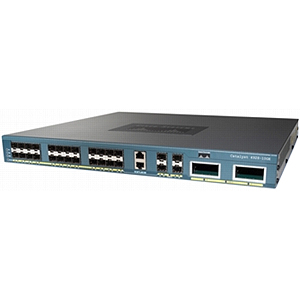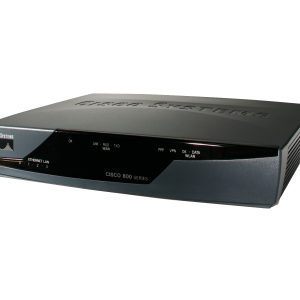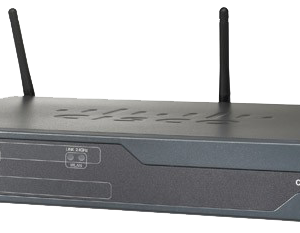Cisco Switch PN WS-C4928-10GE
Original price was: $43,500.00.$22,619.00Current price is: $22,619.00.
Cisco Switch PN : WS-C4928-10GE
The Cisco Catalyst 4928 10 Gigabit Ethernet Switch (4928-10GE) is a wire-speed, Layer 2 to 4, 1-rack-unit (1RU) switch designed for space-constrained LAN distribution and core applications. Based on the proven Cisco Catalyst 4500 Series hardware and software architecture, this switch offers exceptional performance, bandwidth, and reliability for medium-density, multilayer aggregation of high-performance LAN access switches. High performance and scalability of intelligent network services are made possible with dedicated specialized resources known as ternary content addressable memory (TCAM). Ample TCAM resources (64,000 entries) enable high feature capacity, providing wire-speed routing and switching performance with concurrent provisioning of services such as quality of service (QoS) and security, helping ensure scalability for today?s network requirements with ample room for future growth.
Product Description
Cisco Switch PN WS-C4928-10GE
The Cisco Catalyst 4928 10 Gigabit Ethernet Switch (4928-10GE) is a wire-speed, Layer 2 to 4, 1-rack-unit (1RU) switch designed for space-constrained LAN distribution and core applications. Based on the proven Cisco Catalyst 4500 Series hardware and software architecture, this switch offers exceptional performance, bandwidth, and reliability for medium-density, multilayer aggregation of high-performance LAN access switches. High performance and scalability of intelligent network services are made possible with dedicated specialized resources known as ternary content addressable memory (TCAM).
Ample TCAM resources (64,000 entries) enable high feature capacity, providing wire-speed routing and switching performance with concurrent provisioning of services such as quality of service (QoS) and security, helping ensure scalability for today?s network requirements with ample room for future growth.
The Cisco Catalyst 4928 10 Gigabit Ethernet Switch offers 28 wire-speed 1000BASE-X Small Form-Factor pluggable (SFP) ports and 2 wire-speed 10 Gigabit Ethernet (X2 optics) ports. Exceptional reliability and serviceability are delivered with optional internal AC or DC 1 + 1 hot-swappable power supplies and a hot-swappable fan tray with redundant fans
Important Information
We are not only looking to sell you only one time we look to build long business relation with you.
Warranty & Support
We offer manufacture warranty plus our ICT warranty.
If you need any technical assistant, our expert technicians are always available to help you without any additional cost.
Contact us now and let our team help you.
| Features | Specifications |
| Layer 2 Features | ?Layer 2 hardware forwarding at 72 mpps?Layer 2 switch ports and VLAN trunks?IEEE 802. 1Q VLAN encapsulation?Inter-Switch Link (ISL) VLAN encapsulation?Dynamic Trunking Protocol (DTP)?VLAN Trunking Protocol (VTP) and VTP domains?Support for 2048 VLANs per switch?PVST and PVST+?Flexlink?Spanning Tree PortFast and PortFast Guard?Spanning Tree UplinkFast and BackboneFast?IEEE 802.1s?IEEE 802.1w?IEEE 802.3ad?Spanning Tree Root Guard?Cisco Discovery Protocol Versions 1 and 2?Internet Group Management Protocol Version 1 (IGMPv1), v2, and v3 snooping?Cisco EtherChannel technology, Cisco Fast EtherChannel technology, and Cisco Gigabit EtherChannel technology?Port Aggregation Protocol (PAgP)?Link Aggregation Control Protocol (LACP)?Unidirectional link detection (UDLD) and aggressive UDLD?IEEE 802.1 QinQ in hardware?Layer 2 protocol tunneling?Layer 2 Tunneling Protocol (L2TP)?Multilayer Jumbo Frames (up to 9216 bytes)?Baby Giants (up to 1600 bytes)?Unidirectional Ethernet?Storm control (formally known as broadcast and multicast suppression)?Forced 10/100 autonegotiation?Web Cache Communications Protocol (WCCP) Version 2?Layer 2 redirect?Private VLAN promiscuous trunk?Layer 2 promiscuous trunk over trunk port (L2PT)?Class-of-service (CoS) mutation?E-OAM 802.3ah and CFM: 802.1ag |
| Layer 3 Features | ?Jumbo Frames on all ports (up to 9216 bytes)?Hardware-based IP Cisco Express Forwarding routing at 72 mpps?IP routing protocols: EIGRP, OSPF, RIP, and RIPv2?BGP4 and Multicast Border Gateway Protocol (MBGP)?Nonstop Forwarding (NSF) Awareness?Hot Standby Router Protocol (HSRP) v1 and v2?Software routing of Internetwork Packet Exchange (IPX) and AppleTalk?IS-IS routing protocol?IGMPv1, v2, and v3?IGMP filtering on access and trunk ports?IP Multicast routing protocols: Protocol Independent Multicast (PIM), Source Specific Multicast (SSM), and Distance Vector Multicast Routing Protocol (DVMRP)?Autorendezvous point (Auto-RP)?Pragmatic General Multicast (PGM)?Cisco Group Multicast Protocol server?Full Internet Control Message Protocol (ICMP) support?ICMP Router Discovery Protocol?Policy-Based Routing (PBR)?Virtual Route Forwarding lite (VRF-lite)?IPv6 (software switched)?OSPF fast convergence?EIGRP stub?Virtual Router Redundancy Protocol (VRRP)?IP unnumbered for SVI?NSF Awareness?WCCPv2?Gateway Load Balancing Protocol (GLBP) |
| High-Availability Features | ?1 + 1 hot-swappable AC or DC power supplies?Hot-swappable field-replaceable fan tray with redundant fans?HSRP v1 and v2?VRRP?Cisco IOS Embedded Event Manager (EEM)?Cisco Generic Online Diagnostics (GOLD)?Smart Call Home |
| Sophisticated QoS and Traffic Management | ?Per-port QoS configuration?Support for four queues per port?Strict Priority Queuing?IP differentiated services code point (DSCP)?Classification and marking based on IP type of service (ToS) or DSCP?Classification and marking based on full Layer 3 and 4 headers?Input and output policing based on Layer 3 and 4 headers?Support for 512 policers on ingress and 512 policers on egress?Shaping and sharing output queue management |
| Dynamic Buffer Limiting (DBL) Congestion-Avoidance Feature | ?No performance penalty for granular QoS functions?Per-port, per-VLAN QoS?Match CoS for non-IPv4 traffic |
| Predictable Performance | ?96-Gbps switching fabric?Layer 2 hardware forwarding at 72 mpps?Layer 3 hardware-based IP Cisco Express Forwarding routing at 72 mpps?Layer 4 TCP and User Datagram Protocol (UDP) hardware-based filtering at 72 mpps?No performance penalty with advanced Layer 3 and 4 services enabled?Software-based learning at a sustained rate of 3000 hosts per second?Support for 55,000 unicast and 16,000 multicast MAC addresses?Support for 32,000 entries in routing table (shared between unicast and multicast)?Scalability to 2000 virtual ports (VLAN port instances)?Bandwidth aggregation up to 40 Gbps using Cisco Gigabit Ethernet EtherChannel technology |
| Technology | ?Hardware-based multicast management?Hardware-based access control lists (ACLs), router ACLs (RACLs), and VLAN ACLs (VACLs)?Comprehensive management?Manageable through Cisco Network Assistant?Single console port and single IP address to manage all system features?Software configuration management, including local and remote storage?Manageable through CiscoWorks Windows network-management software on a per-port and per-switch basis, providing a common management interface for Cisco routers, switches, and hubs?SNMPv1, v2, and v3 instrumentation, delivering comprehensive in-band management?CLI-based management console to provide detailed out-of-band management?RMON software agent to support four RMON groups (history, statistics, alarms, and events) for enhanced traffic management, monitoring, and analysis?Support for all nine RMON groups through the use of a Cisco SwitchProbe analyzer (SPAN) port, which permits traffic monitoring of a single port, a group of ports, or the entire switch from a single network analyzer or RMON probe?Analysis support, including ingress port, egress port, and VLAN SPAN?Layer 2 traceroute?Remote SPAN (RSPAN)?Cisco SmartPort macros?SPAN ACL filtering?Dynamic Host Configuration Protocol (DHCP) client autoconfiguration?Enhanced SNMP MIB support?HTTPS?MAC address notification?Onboard failure logging (OBFL)?Network Mobility Service Protocol (NMSP) |
| Advanced Security | ?TACACS+ and RADIUS, which enable centralized control of the switch and restrict unauthorized users from altering the configuration?Standard and extended ACLs on all ports?IEEE 802. 1x user authentication (with VLAN assignment, voice VLAN, port security, guest VLAN, private guest VLAN, private VLAN, and RADIUS-supplied session timeout extensions)?IEEE 802.1x accounting?IEEE 802. 1x authentication failure?IEEE 802. 1x private VLAN assignment?IEEE 802. 1x private guest VLAN?IEEE 802. 1x RADIUS-supplied timeout?IEEE 802.1x Mac-Auth-Bypass?IEEE 802.1x inaccessible authentication bypass?IEEE 802.1x Cisco Network Admission Control (NAC) Layer 2?Cisco NAC Layer 2 IP?Cisco NAC Layer 2 IP inaccessible authentication bypass?Trusted boundary?RACLs on all ports (no performance penalty)?VACLs?Port ACLs (PACLs)?Private VLANs (PVLANs) on access and trunk ports?DHCP snooping?DHCP Option 82?DHCP Option 82 insertion?DHCP Option 82 pass-through?Port security?Port security for PVLAN ports?Sticky port security?Secure Shell (SSH) Protocol Versions 1 and 2?VLAN Management Policy Server (VMPS) client?Unicast MAC filtering?Unicast port flood blocking?Dynamic Address Resolution Protocol (ARP) inspection?IP Source Guard?Community PVLANs?Trunk port security?IEEE 802.1x inaccessible authentication bypass?MAC authentication bypass?Control Plane Policing?IEEE 802.1x unidirectional controlled port?Voice VLAN sticky port security?Secure Copy Protocol (SCP)?Cisco EtherChannel trunk port security |
| Management | ?Enhanced Object Tracking (EOT)?IP service-level agreement (SLA)?CiscoWorks LAN Management Solution (LMS), including CiscoWorks Resource Manager Essentials (RME)?CiscoWorks CiscoView?Cisco Network Assistant?BGP4-MIB.my?BRIDGE-MIB.my (RFC 1493)?Static multicast MAC address in BRIDGE-MIB?CISCO-BULK-FILE-MIB.my?CISCO-CDP-MIB.my?CISCO-CLASS-BASED-QOS-MIB.my?CISCO-CONFIG-COPY-MIB.my?CISCO-CONFIG-MAN-MIB.my?CISCO-ENTITY-ASSET-MIB.my?CISCO-ENTITY-EXT-MIB.my?CISCO-ENTITY-FRU-CONTROL-MIB.my?CISCO-ENTITY-SENSOR-MIB.my?CISCO-ENTITY-VENDORTYPE-OID-MIB.my?CISCO-ENVMON-MIB.my?CISCO-FLASH-MIB.my?CISCO-FTP-CLIENT-MIB.my?CISCO-HSRP-MIB.my?CISCO-IETF-IP-MIB.my?CISCO-IETF-IP-FORWARD-MIB.my?CISCO-IETF-ISIS-MIB.my?CISCO-IF-EXTENSION-MIB.my?CISCO-IGMP-FILTER-MIB.my?CISCO-IMAGE-MIB.my?CISCO-IPMROUTE-MIB.my?CISCO-L2-TUNNEL-CONFIG-MIB.my?CISCO-L2L3-INTERFACE-CONFIG-MIB.my?CISCO-LAG-MIB.my?CISCO-MEMORY-POOL-MIB.my?CISCO-NDE-MIB.my?CISCO-PAGP-MIB.my?CISCO-PAE-MIB.my?CISCO-PING-MIB.my?CISCO-PORT-SECURITY-MIB.my?CISCO-PORT-STORM-CONTROL-MIB.my?CISCO-PRIVATE-VLAN-MIB.my?CISCO-PROCESS-MIB.my?CISCO-PRODUCTS-MIB.my?CISCO-RF-MIB.my?CISCO-RMON-CONFIG-MIB.my?CISCO-RTTMON-MIB.my?CISCO-STP-EXTENSIONS-MIB.my?CISCO-SYSLOG-MIB.my?CISCO-VLAN-IFTABLE-RELATIONSHIP-MIB.my?CISCO-VLAN-MEMBERSHIP-MIB.my?CISCO-VTP-MIB.my?DOT3-MAU-MIB.my (RFC 3636)?ENTITY-MIB.my?ETHERLIKE-MIB.my?EXPRESSION-MIB.my?HC-RMON-MIB.my?IEEE8021-PAE-MIB.my?IEEE8023-LAG-MIB.my (802.3ad)?IF-MIB.my?IGMP-MIB.my?IPMROUTE-MIB.my?NOVELL-IPX-MIB.my?NOVELL-RIPSAP-MIB.my?OLD-CISCO-TS-MIB.my?PIM-MIB.my?RFC1213-MIB.my (MIB-II)?RFC1243-MIB.my (APPLETALK MIB)?RFC1253-MIB.my (OSPF-MIB)?RMON-MIB.my (RFC 1757)?RMON2-MIB.my (RFC 2021)?SMON-MIB.my (Internet-Draft)?SNMP-FRAMEWORK-MIB.my (RFC 2571)?SNMP-MPD-MIB.my (RFC 2572)?SNMP-NOTIFICATION-MIB.my (RFC 2573)?SNMP-TARGET-MIB.my (RFC 2573)?SNMP-USM-MIB.my (RFC 2574)?SNMP-VACM-MIB.my (RFC 2575)?SNMPv2-MIB.my?TCP-MIB.my?UDP-MIB.my?RIP SNMP MIB |
| Industry Standards | ?Ethernet: IEEE 802.3 and 10BASE-T?Fast Ethernet: IEEE 802.3u, 100BASE-TX, and 100BASE-FX?Gigabit Ethernet: IEEE 802.3z and 802.3ab?IEEE 802. 1D Spanning Tree Protocol?IEEE 802.1w rapid reconfiguration of spanning tree?IEEE 802. 1s multiple VLAN instances of spanning tree?IEEE 802.3 ad LACP?IEEE 802. 1p CoS prioritization?IEEE 802.1Q VLAN?IEEE 802. 1x user authentication?X2 support?RMON I and II standards |
| Indicators and Ports | ?System status: Green (operational), or red (faulty)?Console: RJ-45 socket?Reset (switch recessed for protection)?Uplinks: Link and active?Image management port: 10/100BASE-TX (RJ-45 socket) data terminal equipment (DTE); green (good), orange (disabled), or off (not connected) |
The Cisco Catalyst 4928 10 Gigabit Ethernet Switch offers flexible and highly available aggregation solutions for
nonstop unified network services. Enterprise-grade features such as dynamic routing, dual hot-swappable power
supplies, and redundant field-replaceable fans enhance switch availability.
The switch is well-suited for space- and power-constrained deployments because of its compact 1RU form factor,
economical power needs, and efficient cooling. Ideally suited to support secure converged applications such as Cisco
TelePresence and Cisco Unified Communications, the switch delivers high-performance intelligent switching with its
robust feature set.
Wire-Speed Performance in All Directions:
The Cisco Catalyst 4928 10 Gigabit Ethernet Switch delivers wire-speed throughput with low latency for dataintensive
applications using a 96-Gbps switching fabric with a forwarding rate of 72 million packets per second
(mpps) in hardware for Layer 2 to 4 traffic. High-performance switching is maintained regardless of the number of
route entries or Layer 3 and 4 services enabled. Hardware-based Cisco Express Forwarding routing architecture
enables increased scalability and performance. X2 10 Gigabit Ethernet optics provide 20 Gigabit Ethernet wire-speed
uplinks for maximum traffic throughput.
Power-Supply Redundancy for Nonstop Operations:
The Cisco Catalyst 4928 10 Gigabit Ethernet Switch provides reliability for critical applications with 1 + 1 redundant,
hot-swappable internal AC or DC power supplies. The 1 + 1 power supply design provides A-to-B failover when
power supplies are connected to different circuits. You can mix AC and DC power supplies in the same unit for
maximum deployment flexibility. The switch also has a hot-swappable fan tray with four redundant fans for additional
serviceability and availability.
Comprehensive Management:
The Cisco Catalyst 4928 10 Gigabit Ethernet Switch includes a single, dedicated 10/100 console port and a single,
dedicated 10/100 management port for offline disaster recovery and remote out-of-band management. Remote inband
management is available with the Simple Network Management Protocol (SNMP), Telnet Client, Bootstrap
Protocol (BOOTP), and Trivial File Transfer Protocol (TFTP).
The management port has two operating modes designed to increase operational efficiency and availability. When
the system is in Remote Monitoring (RMON) mode, the management port operates in a disaster-recovery mode. In
this state the operator can reload new Cisco IOS Software images from a TFTP server. During normal system



